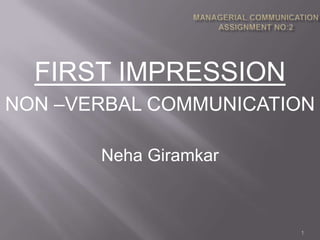
body language
- 1. FIRST IMPRESSION NON –VERBAL COMMUNICATION Neha Giramkar 1
- 2. Non -Verbal Communication : AN OVERVIEW •INTRODUCTION •IMPORTANCE •TYPES OF NON -VERBAL MESSAGES •BODY LANGUAGE •INTERPRETING BODY LANGUAGE •ARTIFACTUAL COMMUNICATION AND COLOR •SPACE AND DISTANCE / PROXEMICS •BARRIERS IN NON VREBAL COMMUNICATION 2
- 3. Non -Verbal Communication is the message or response not expressed or sent in words-hints , suggestions , indications. NVC is the unspoken communication that goes on in every Face-to-Face encounter with another human being. It is recognized as the route to discover what the other side wants, without them ever saying it, like a secret way into their soul. NVC stands for the innermost, instinctual form of human communication. Actions speak louder than words. 3
- 4. Communication researcher Mehrabian found that only 7% of a message’s effect are carried by words ; listeners receive the other 93% through non -verbal means. Birdwhistell suggested that spoken words account for not more than 30-35% of all our social interactions. Over 65 percent of the social meaning of the messages we send to others are communicated non- verbally 4
- 5. A. Body Language orKinesics B. Clothing or Artifactual Communication C. Voice or Paralanguage D. Space and Distance, or Proxemic factors E. Color F. Time, or Chronemics; and G. Touch, or Haptics 5
- 6. “The bodily gestures, postures, and facial expressions by which a person communicates non verbally with others” -(Soukhanov 1992) KINESICS: POSTURE GESTURE FACIAL EXPRESSIONS GAZE / EYE CONTACT 6
- 7. 1.Facial expression(s) 2.Eyes 3.Lips 4.Arms 5.Hands 6.Fingers 7
- 8. The face is an important source of information. Since the face cannot be easily hidden, it is an important source of nonverbal information and communicates a variety of emotions. In addition, eye contact, pupil size, and the smile provide additional cues to informed observers. 8
- 9. Forehead Wrinkles Anger Eyebrows Outer Anger edges up Upward Contempt Nose 9
- 10. A2. Eyes Centered Focused Gazing Up Thinking Shame Gazing Down 10
- 11. A2. Eyes Guilty Gaze on the Side Wondering Disinterested, Bored 11
- 12. A3. Lips Parted Relaxed, Happy Togeth Possibly er Concerned Wide Open Very Angry 12
- 13. A4. Arms Arms Crossed Angry, Disapproving Open Honest, Accepting 13
- 14. Tightly clenched hands usually indicate that the person is experiencing undue pressure. It may be difficult to relate to this person because of his tension and disagreement. Superiority and authority are usually indicated when you are standing and joining your hands behind your back. Rubing gently behind or beside the ear with the index finger or rubbing the eye usually means the other person is uncertain about what you are saying. Leaning back with both hands supporting the head usually indicates a feeling of confidence or superiority. 14
- 15. Cupping one or both hands over the mouth, especially when talking, may well indicate that the person is trying to hide something Putting your hand to your cheek or stroking your chin generally portrays thinking, interest or consideration. Fingers bent across the chin or below the mouth most often shows critical evaluation. 15
- 16. OPEN responsive reflective FORWARD BACK combative fugitive CLOSED 16
- 17. EXAMPLE :1 EXAMPLE:2 ENGAGED leaning EAGER (sprint position) forward Open Legs Open Body Feet under Chair Open Arms On Toes Open Hands Leaning Forward 17
- 18. EXAMPLE:1 EXAMPLE:2 LISTENING with head EVALUATING : tilted sucking glasses / pencil Lots of Eye Contact Stroking Chin Nodding Looking Up and Right High Blink Rate Legs crossed in 4 pos. Ankle on Knee 18
- 19. EXAMPLE:1 EXAMPLE:2 BORED staring into REJECTION space sitting/moving back Slumped Posture Arms Folded Doodling Legs Crossed in 11 pos. Foot Tapping Thigh on Knee Head Down Frown 19
- 20. EXAMPLE:1 EXAMPLE:2 LET ME SPEAK finger AGGRESSIVE leaning tapping forwards Foot Tapping Finger Pointing Staring Fists Clenched 20
- 21. Artifactual communication, is an integral part of the nonverbal package. It includes the use of personal adornments such as clothing, jewellery , makeup, hairstyles People are apt to make inferences about us based on the way we dress 21
- 22. Yellow cheers Red excites Blue comforts and and and elevates moods stimulates soothes In some In some cultures cultures black suggests white suggests mourning purity 22
- 23. Proximity cues, including the treatment of space and territory influence interaction and help define the communication experience. Edward Hall says there are four different distances that we keep between ourselves and other people: intimate distance-0 to 18 inches; personal distance-18 inches to 4 feet; social distance-4 to 12 feet; and public distance-12 feet to the limit of sight. 23
- 24. 1. Flashing or rolling eyes 2. Quick or slow movements 3. Arms crossed, legs crossed 4. Gestures made with exasperation 5. Slouching, hunching over 6. Poor personal care 7. Doodling 8. Staring at people or avoiding eye contact 9. Excessive fidgeting with materials 24
- 25. In the United States it is a symbol for good job In Germany the number one In Japan the number five In Ghana an insult In Malaysia the thumb is used to point rather than a finger 25
- 26. 26